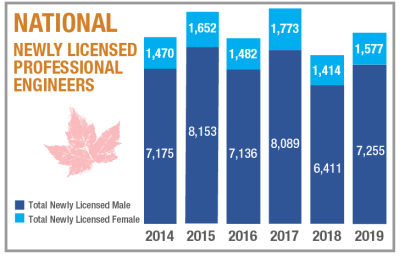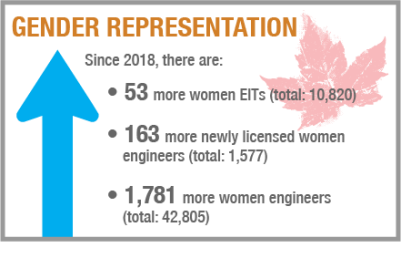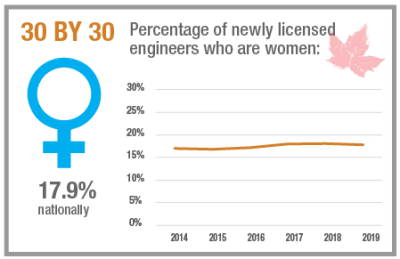Data for 2019
The original post of this report included an error in the number of EITs who are women. The information presented below has been updated accordingly after corrected data was submitted by one of the engineering regulators.
1. Summary
Engineers Canada’s annual National Membership Report collects information from the provincial and territorial engineering regulators about their membership in order to paint a picture of the engineering profession in Canada. The 2020 report captures data from January 1, 2019, to December 31, 2019. Engineer members are categorized based on the definition of practice in each jurisdiction. Please find here all data tables associated with this report.
2. Growth in the engineering profession
 Membership in the provincial and territorial regulators increased from 2018 to 2019. There were 304,785 members1 as of December 31, 2019 across the 12 engineering regulators comprising the national total membership (see Table 1).This is an increase of 1,909 members, or 0.6 per cent growth (in 2018 the increase was 2.3 per cent).2 While membership declined in some jurisdictions, the largest growth in numbers was seen in British Columbia (2,154 engineers), followed by Ontario (1,917 engineers).
Membership in the provincial and territorial regulators increased from 2018 to 2019. There were 304,785 members1 as of December 31, 2019 across the 12 engineering regulators comprising the national total membership (see Table 1).This is an increase of 1,909 members, or 0.6 per cent growth (in 2018 the increase was 2.3 per cent).2 While membership declined in some jurisdictions, the largest growth in numbers was seen in British Columbia (2,154 engineers), followed by Ontario (1,917 engineers).
3. Newly licensed engineers
 To understand the future of the profession, we track the number of newly licensed engineers3 each year. There were 8,833 newly licensed engineers in 2019, with the largest number (3,130 engineers) obtaining their licence through Professional Engineers Ontario (PEO) (see Table 2). Nationally, the number of newly licensed engineers increased between 2018 and 2019, from 7,825 to 8,833. For the six-year trend in newly licensed engineers (2014 to 2019) see Table 3. Of the three categories that account for the number of newly licensed engineers (ie. Canadian Engineering Accreditation Board [CEAB], internationally trained, and obtaining their licence by another route), the number of engineers obtaining their licence by another route grew from 75 engineers in 2018, to 244 in 2019. This third pathway saw a large increase in male licencees in New Brunswick and warrants further investigation to better define this route to licensure. Further analysis of the CEAB pathway to licensure is captured in the section called ‘Gender representation in engineering.’
To understand the future of the profession, we track the number of newly licensed engineers3 each year. There were 8,833 newly licensed engineers in 2019, with the largest number (3,130 engineers) obtaining their licence through Professional Engineers Ontario (PEO) (see Table 2). Nationally, the number of newly licensed engineers increased between 2018 and 2019, from 7,825 to 8,833. For the six-year trend in newly licensed engineers (2014 to 2019) see Table 3. Of the three categories that account for the number of newly licensed engineers (ie. Canadian Engineering Accreditation Board [CEAB], internationally trained, and obtaining their licence by another route), the number of engineers obtaining their licence by another route grew from 75 engineers in 2018, to 244 in 2019. This third pathway saw a large increase in male licencees in New Brunswick and warrants further investigation to better define this route to licensure. Further analysis of the CEAB pathway to licensure is captured in the section called ‘Gender representation in engineering.’
4. Engineers-in-training
 The number of engineers-in-training (EITs) decreased between 2018 and 2019, by 1,258 members. While the number of EITs who are men declined by 1,443 between 2018 and 2019, the number of EITs who are women increased by 53 more than in 2018. See Table 4 to see the national EIT data from 2014 to 2019.
The number of engineers-in-training (EITs) decreased between 2018 and 2019, by 1,258 members. While the number of EITs who are men declined by 1,443 between 2018 and 2019, the number of EITs who are women increased by 53 more than in 2018. See Table 4 to see the national EIT data from 2014 to 2019.
5. Gender representation in engineering
 There are 42,305 women who are engineering members, representing 13.9 per cent of total national membership in 2019 (an increase from 13.5 per cent in 2018). This is an increase of 1,781 engineering members who are women between 2018 and 2019. The largest growth in members who are women was seen in British Columbia, with an increase of 706 members between 2018 and 2019. Looking at the two-year trend, the rate of change from year to year was smaller from 2018 to 2019 (4.16 per cent) than it was from 2017 to 2018 (5.5 per cent).
There are 42,305 women who are engineering members, representing 13.9 per cent of total national membership in 2019 (an increase from 13.5 per cent in 2018). This is an increase of 1,781 engineering members who are women between 2018 and 2019. The largest growth in members who are women was seen in British Columbia, with an increase of 706 members between 2018 and 2019. Looking at the two-year trend, the rate of change from year to year was smaller from 2018 to 2019 (4.16 per cent) than it was from 2017 to 2018 (5.5 per cent).
Engineers Canada and the regulators have been tracking the number of newly licensed women since 2014, as part of the 30 by 30 initiative. In 2015, Engineers Canada launched the 30 by 30 initiative with support from the provincial and territorial regulators. 30 by 30 is a commitment to increasing the proportion of newly licensed engineers who are women to 30 per cent by 2030. This is an important metric for tracking the impact of programs that support gender equity in engineering, since it marks a career milestone for women in their early careers, post-graduation from an accredited program, or for internationally trained engineers entering the Canadian job market.
This is an important metric for tracking the impact of programs that support gender equity in engineering, since it marks a career milestone for women in their early careers, post-graduation from an accredited program, or for internationally trained engineers entering the Canadian job market.
Women accounted for 17.9 per cent of newly licensed engineers in Canada in 2019 (see Table 2). The total number of women obtaining their license between 2018 and 2019 increased from 1,414 (2018) to 1,577 (2019). The number of newly licensed men grew at a higher rate than the number of newly licensed women between 2018 and 2019, causing a lower percentage representation for newly licensed women between 2018 and 2019 (18.1 per cent in 2018 to 17.9 per cent in 2019).
The largest increases, by region, of newly licensed engineers who are women between 2018 and 2019 occurred in Ontario (from 471 to 570), Quebec (from 385 to 425), and British Columbia (129 to 162). Alberta, Manitoba, and Newfoundland and Labrador saw declines in both women and men obtaining their licence.
The number of women EITs increased between 2018 and 2019, bringing the percentage of women EITs to the highest level they have been at since 2014 at 21.2% per cent. See Table 4 for the full breakdown of male and female EITs.
Engineering student membership also saw an increase in women members. The representation of engineering students who identify as women grew from 23.7 per cent to 25.2 per cent between 2018 to 2019.
6. From engineering student to professional engineer
Gathering data on the number of engineering students helps us understand how the engineering profession might grow in the future.
According to Engineers Canada’s report on engineering enrolment and graduation numbers, there were 14,557 graduates from accredited post-secondary engineering programs in 2015.4 Assuming it takes a minimum of four years for a graduate from an accredited engineering program to obtain their professional licence, we can estimate that those 2015 graduates (Cohort A) would be obtaining their engineering licence in 2019 and would be captured in the number of newly licensed engineers in this year’s membership data. Using these figures, we can calculate an estimation of the national conversion from graduation to engineering licensure.
In 2019, CEAB graduates made up 71 per cent of the total newly licensed engineers in Canada. This number went from 5,554 in 2018 to 6,290 in 2019 (see Table 2). Based on the number of newly licensed CEAB graduates in 2019, we estimate 42 per cent of Cohort A (2015) proceeded along the path to licensure. This is an increase from the previous cohort, where 40 per cent of the 2014 CEAB cohort were estimated to have received their license in 2018. Although this is an estimation, it is an attempt at measuring the successful continuation of engineering students along the pathway to licensure.
This analysis is particularly important in understanding the trend for 30 by 30 and how it relates to the increasing trend of female undergraduate enrolment and graduation. CEAB graduates make up the largest pool of potential engineers, including the largest number of newly licensed engineers who are women. Tracking the numbers of women in Cohort A we see that 2,615 engineering graduates were women. In 2019, 1,165 women were newly licensed by the regulators (Table 2). Using the 4-year graduate to licensure estimation we find a 45 per cent licensure obtainment rate in 2019 for Cohort A who are women, which is close to the overall conversion rate for Cohort A (42 per cent). Women are continuing on the pathway to licensure at a similar rate as their male colleagues upon graduation.
To find out more about the 30 by 30 initiatives and the 30 by 30 Champions in your province, visit the 30 by 30 webpage.
1 The category, Members, includes Practising P.Eng.’s (exclusive), Temporary License Holders, License to Practise Holders, Restricted License Holders, Non-Practising P.Eng.’s, Life Members and Engineers-in-Training. It does not include students.
2 Engineers Canada, 2019. “2019 National Membership Information.” Engineers Canada, Ottawa, Canada. Available: https://engineerscanada.ca/reports/national-membership-report/2019 [Accessed July 23, 2020].
3 The category, Newly Licensed, includes individuals licensed as Professional Engineers for the first time that are Canadian Engineering Accreditation Board trained, Internationally trained, or have obtained their license by some other route. It does not include interprovincial mobility applicants.
4 Engineers Canada, 2020. “Canadian engineers for tomorrow,” Engineers Canada, Ottawa, Canada. Available: https://engineerscanada.ca/publications/canadian-engineers-for-tomorrow-2018#total-undergraduate-degrees-awarded. [Accessed July 23, 2020].
Note on gender definition: gender identifiers have historically been limited to ‘male’ and ‘female’ in the survey of national membership. However, some regulators have indicated that they are collecting non-binary gender data, and one regulator provided data on members who submit ‘gender unknown’ in their surveys. For future data collection, Engineers Canada will begin collecting gender non-binary membership data.
